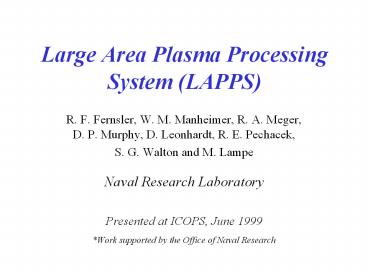Large Area Plasma Processing System (LAPPS) PowerPoint PPT Presentation
Title: Large Area Plasma Processing System (LAPPS)
1
Large Area Plasma Processing System (LAPPS)
- R. F. Fernsler, W. M. Manheimer, R. A. Meger, D.
P. Murphy, D. Leonhardt, R. E. Pechacek, - S. G. Walton and M. Lampe
- Naval Research Laboratory
- Presented at ICOPS, June 1999
- Work supported by the Office of Naval Research
2
Outline
- General description of LAPPS
- Experiments
- See Poster 6P01 for details.
- Physics
- Comparison with other sources
- Summary
3
LAPPS Overview
- A magnetically confined, sheet electron beam is
used to ionize a gas. - Purpose Create a cold, weakly ionized, planar
plasma for material processing. - Key distinguishing features
- Beam ionization replaces plasma heating.
- Large processing area ( 1 m2).
- Limited by the size of the vacuum chamber and
power.
4
Experimental Program
- Status
- ne 5x1012 cm-3 over 60 x 60 x 2 cm.
- Wide range of gases, 20-300 mtorr.
- Etch rate in oxygen gt 6 mm/min.
- Grounded stage (no bias).
- Immediate Plans
- Extend area to 1 m2.
- Etch with rf bias.
- Investigate other beam sources.
- Present source is a hollow-cathode discharge.
- Diagnostics Langmuir probe, m-wave and optical,
electron energy analyzer, mass spectrometer, SEM.
5
Processing Objectives
- Large area.
- But thin to minimize electrical power.
- Independent control of ion and free-radical
fluxes. - Wide operating range in power, gas and bias.
- High uniformity.
- Efficient.
- Low Te.
- To maximize ion anisotropy.
6
Design Constraints
- Beam current and energy.
- Gas pressure and composition.
- Magnetic field.
- Particle fluxes.
7
Beam Energy
- Energy loss rate
- N gas density, Z atomic number, eo 100 eV.
- Beam range
- Increase R by raising eb or reducing N.
- R gt 1 m in 100 mtorr ? eb 3 keV.
- N 20 mtorr to avoid two-stream instability.
8
Beam Current
- Gas ionization rate
- jb beam current density, wi _at_ 30 eV per e-i
pair. - Loss rate, worst case
- Where b 5x10-8 cm3/s (for eAB ? AB).
- ne 1012 cm-3 requires jb _at_ 10 mA/cm2.
- nb/ne lt 10-4.
- Dissociation rate
- Metastable rate Sm ltlt Si.
9
Beam Confinement
- Elastic collisions cause the beam to spread.
- Apply Bz to keep the gyroradius rc lt dxb.
- dxb beam thickness.
- rc lt 1 cm at 3 keV ? Bz 200 G.
10
Effect of Bz on the Plasma
- Outward plasma flow produces a diamagnetic
current circulating around the plasma - Bz ?
- Only the electrons are strongly magnetized.
- Outward flow is impeded if
- m mass, n collision frequency of ions
electrons. - n ? N ? Flow is impeded when Bz/N 2 kG/torr.
11
Electron Temperature Te
- Initial mean energy of secondary electrons
- Ii ionization energy.
- Effective heating rate
- Collisional cooling Te Te(Q).
- Predict Te lt 1 eV in molecular gases.
- Consistent with Langmuir probe.
- Predict Te gt 1 eV in noble gases.
- Can raise Te with external heating.
12
Particle Fluxes
- Fluxes
- Bz and recombination limit the ion flux to
- Increase Bz or Dx to decrease Fi.
- Add an atomic gas (b ? 0) to increase Fi.
- Free-radical flux
- Independent of Bz, Dx, or atomic additives.
beam/plasma
Dx
Fi ,Fr
substrate
13
Uniformity
- jb _at_ constant but eb falls with z.
- Si and ne thus rise (smoothly) with z.
- One solution is to increase eb(0).
- Decreases efficiency, unless the energy is
recovered prior to the beam dump. - Other solutions
- Vary Bz(z) or Dx(z) to make Fi more uniform.
- Vary N(z) to make Fi and Fr more uniform.
- Move the stage.
14
Conventional Sources
- Heat the plasma to produce ionization.
- Te gt 2 eV.
- Inefficient wi gtgt I1 (in processing gases).
- Energy goes mainly to low-lying excitation.
- Restricted operating range.
- In gas type, pressure and power.
- Limited control.
- Species with low Ii are ionized preferentially.
- Heating zone is determined by E-to-ne coupling.
15
LAPPS Issues
- Requires
- Beam source.
- Isolation of the source from the processing
region. - Bz.
- Beam-plasma instabilities.
- Suppressed by collisions and beam velocity
spread. - RF bias
- Small ground electrode(s).
- Effect of Bz on the sheath.
16
LAPPS Summary
- Plasma density ne ? 5x1012 cm-3 (above 20 mtorr).
- Area 1 m2.
- Limited by chamber size and power.
- Works in all gases over a wide pressure range.
- Ionization rate depends mainly on concentration.
- Independent control of ion and radical fluxes.
- Smooth (no hot spots).
- But some variation along Bz.
- Efficient.
- Thin.
- wi _at_ 30 eV, depending on tradeoff for uniformity
along Bz. - Te lt 1 eV.

